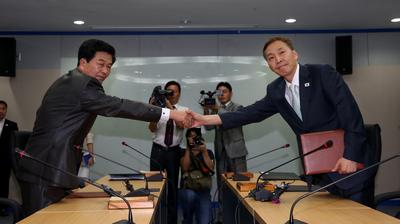On the other hand however, economic engagement, if successful, could lead to political and economic reform, integration, and eventually even reunification with South Korea. After all, inter-Korean commercial trade was originally established with this very political objective in mind.
According to Ernst Haas, an American political scientist, economic cooperation results in political integration because of a ‘positive spillover effect’. Former Korean president Kim Dae-jung had this theory in mind when he came up with the Sunshine Policy. Since then, the South Korean government has aimed to gradually change the North Korean regime by exposing it to the outside world through economic projects. This, so the theory goes, would lead to incremental reforms in domestic politics. North Korea might then begin to work according to international norms and institutions rather than oppose them outright. There’s no doubt the North Korean people would benefit from the economic and social rejuvenation that would follow.
North Korea is wedged between South Korea, China and Russia, so it could act as South Korea’s economic gateway to Eurasia. South Korea would benefit substantially from such a development due to its small national territory and limited natural resources.
South Korean presidents and politicians have long dreamt of building a modern version of the Silk Road through the North. Former president Kim Dae-jung was the first political leader to enunciate plans to develop Korea as a center for logistics throughout Northeast Asia. Another former president, Roh Moo-hyun, viewed Korea ‘as a gateway of peace that connects the Eurasian landmass with the Pacific’. The former president Lee Myung-bak’s ‘four-river grand canal project’ included a blueprint to connect two Koreas through a water system for ‘logistics revolution’.
In addition to political mistrust and a lack of communication and mutual understanding, and the underdevelopment of transport logistics systems is a major obstacle for the expansion of inter-Korean trade. Ninety-five per cent of logistical flows are dependent on marine transportation, as land routes through the Kaesung Industrial Park are yet to be fully established. The shipping route has problems, too, because one enterprise has a monopoly. Companies dependent on the system have complained about inconvenient scheduling and frequent delays, as well as high costs and outdated facilities.
While solely inter-Korean exchanges have been inefficient, the process works relatively more smoothly when China is involved. China has taken a central role in connecting South and North Korea and even influencing the whole Northeast Asia region by building transportation infrastructure in the Changjitu National Cooperation Zone, which connects Changchun, Jilin and the Tumen River area with North Korea.
In terms of developing transportation systems in particular, China has built a new bridge over the Yalu River connecting Dandong to North Korea, which is where 70 per cent of North Korea–China trade is conducted. North Korea also allows China to use the Najin port, which is located in the cooperation zone in North Korea’s northern Hamgyong province. Currently 10 per cent of the total Chinese budget for the Changjitu zone is spent on building transportation and logistics networks.
China has strong political, economic and cultural ties with North Korea. With bilateral trade valued at US$5.7 billion, China is North Korea’s most important partner. Given unofficial trade ties between the two countries, the actual volume is assumed to be much larger than what is publicly acknowledged.
China is likely to continue investing in the North, including by building more transportation systems, given it is afraid of a scenario in which North Korea collapses unexpectedly, which would put enormous pressure on China domestically. An increase in North Korean refugee flows, which have already caused a diplomatic conflict between China, North Korea, and South Korea, and abrupt termination of trade could directly affect stability in at least three of China’s Northeast provinces and beyond.
While other countries in Northeast Asia have become an origin and market for the world’s leading corporations, North Korea lags behind. If other nations were willing to follow South Korea and China’s strategy of utilising trade for as a means of engagement to promote stability and reform it is possible that North Korea could be gradually coaxed out of its isolation. One day North Korea could even become an integral part of a new Silk Road starting in Seoul and extending throughout Eurasia.
This article is based on a personal research paper, ‘Strategies for South Korean Logistics Companies for Northeast Asian Market (동북아 시대 한국의 물류 전략)’, by Jihye Lim and Sookyung Koo.
Sookyung Koo is a Washington DC-based researcher in international affairs and Jihye Lim is a PhD student at George Mason University.

